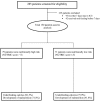Identifying Critically Ill Patients at Risk of Malnutrition and Underfeeding: A Prospective Study at an Academic Hospital
- PMID: 31380259
- PMCID: PMC6664107
- DOI: 10.15171/apb.2019.037
Identifying Critically Ill Patients at Risk of Malnutrition and Underfeeding: A Prospective Study at an Academic Hospital
Abstract
Purpose: Malnutrition is highly prevalent in critically ill patients and is associated with the increased healthcare-related cost and poor patient outcomes. Identifying the factors associated with undernutrition may assist nutritional care. Therefore, this study was designed to identify factors associated with malnutrition and inadequate energy intake to improve nutritional support in intensive care unit (ICU). Methods: This prospective study was conducted on 285 random samples of ICU patients. We reported time to initiate the enteral nutrition, percent of the adequately received nutrition, and development of malnutrition during the follow-up period. Moreover, variables and clinical outcomes associated with calories underfeeding and malnutrition were reported. Results: In 28.6% of samples, enteral feeding was initiated greater than 48 hours after ICU admission. During follow-up, 87.4% and 83.3% of patients failed to receive at least 80% of protein and energy target, and malnutrition developed in 84% of study population. Moreover, surgical and medical patients compared to trauma patients were associated with underfeeding. However, only nutrition risk in the critically ill score (NUTRIC) score ≥5 could predict malnutrition development in our study. Finally, underfeeding contributed significantly to a more mortality rate both in ICU and hospital. Conclusion: Our findings revealed that the majority of nutritionally high-risk patients failed to receive adequate calories and subsequently developed malnutrition. The present study added valuable information to the small body of literature about the factors affecting nutritional decline and malnutrition during the ICU stay.
Keywords: Food intake; Intensive care unit; Malnutrition; Nutritional decline.
References
-
- Wray CJ, Mammen JM, Hasselgren PO. Catabolic response to stress and potential benefits of nutrition support. Nutrition. 2002;18(11-12):971–7. - PubMed
LinkOut - more resources
Full Text Sources
Medical

